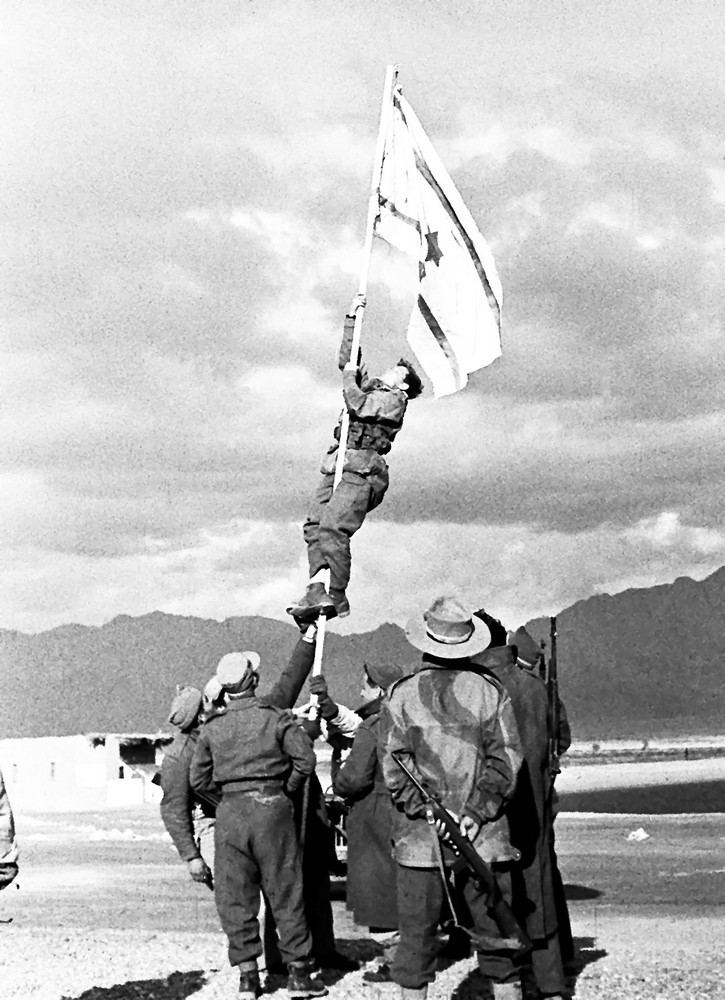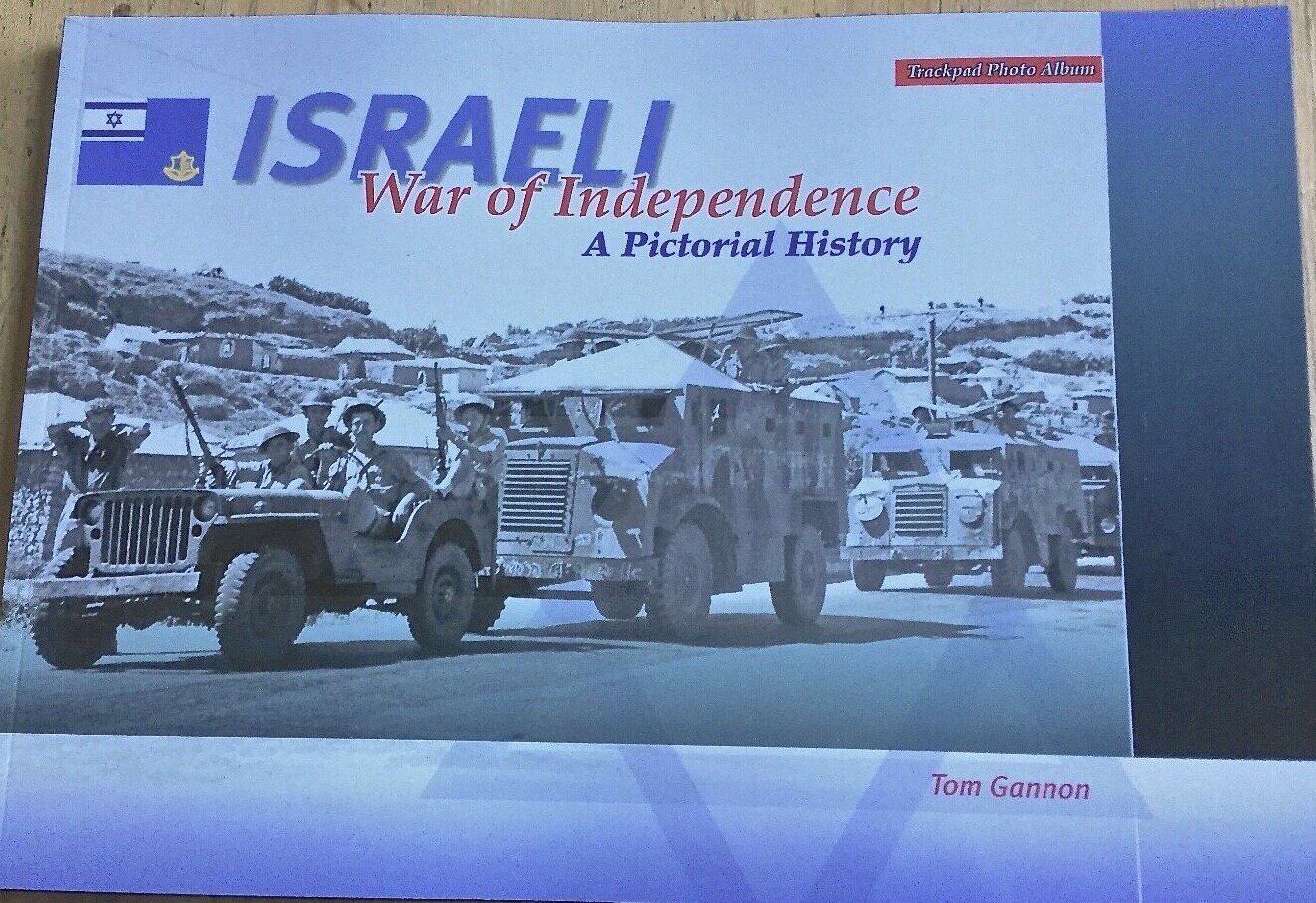Brief History
The Arab Israeli War of 1948, otherwise known as Israel’s War of Independence, or “the nakbah” or disaster to the Arab world because a Jewish state was established, the war was fought between the newly established Jewish state of Israel opposed by Palestinian irregulars, and armies from five Arab states. Official beginning of the war is usually given as May 14, 1948, the date Israel declared itself an independent Jewish state, but the war’s first of four phases began in November 1947. Lasting for two years, the war ended with armistice agreements signed in 1949 between Israel and four Arab states. Brokered by the United Nations, these agreements did not result in the Arab world’s diplomatic recognition of Israel. Instead, a ‘technical’ state of war characterized Arab-Israeli relations until 1979, when the Egypt-Israeli Peace Treaty was signed.
The book.
Israeli war of independence is a pictorial history Published by Trackpad Publishing has a pagination of 186 pages softback book glued spine.
The Author.
Tom Gannon. Born in January 1949, the author grew up near Baltimore, Maryland in the United States of America. A business credit manager by profession, his hobby interests include armour modelling and researching Sherman tanks and the Israeli Defence Forces. He is a regular visitor to various Internet armour discussion forums and has presented seminars on armour subjects at model shows in the US.
He is married to the love of his life, Connie Baker. Between them, they have four children and five grandchildren: Bryan Gannon Heather (Gannon) Eyler, married to Herb, with granddaughter, Julia Melissa Baker, married to Thomas Lanagan, with granddaughters, Cora, and Charlie Ann Justin Baker, married to Laurie, with grandsons, Dylan, and Reid.
Contents
In the Beginning
Notrut Program: Before 1940
Phase One: November 29th, 1947, through April 1st, 1948
Phase Two: April 1st, 1948, through to May 15th, 1948
First Truce and Phase Three: May 15th, through to July 19th, 1948
Second Truce: July 18th, to October 15th, 1948
Phase Four: October 15th, 1948, through to the End
Yo’av to the start of Horev: October 19th through to December 19th, 1948
Mivtza Horev: December1948
The End of the Beginning… Mivtza Uvda
The Review
Without going into the depths of an historic, yet difficult political history of the Middle East, especially the ongoing Arab/Israeli conflicts. It is however to understand that fighting in the region predates the 20th Century. Various opinions aside the entity known as Palestine has never been an independent nation. Arabs as they are known today, arrived in the area by way of the Islamic Empire’s invasion in 636 AD. Jews, otherwise known as Hebrews or Israelites were already in the area as of 1200 BC Exactly how that presence began depends upon reading the Biblical version which describes a violent attack by the Hebrews, after their departure/escape from Egypt against the indigenous Canaanites, or a non-violent assimilation as scribed to by several modern scholars. Some recent studies, including the analysis of certain archaeological and ‘written’ evidence, may add a third alternative which is that the early Israelites were, in fact, ‘Canaanites’ themselves. The history of the political and land gain continues in some depth the small part for which I thought would at least give you an idea of how this all started and came about would give you a small insight into the situation that has been fluid for hundreds of years.
During 1936-1938 tensions flared up between Arabs and Jews which then erupted into the Arab Revolt, British patrols throughout Mandatory Palestine increased. Even though these men have slight smiles on their faces, they are nonetheless alert for attacks near the Jerusalem Citadel (Tower of David), not far from the Jaffa Gate in the western part of the city. Note the Lewis machine gun, just in case. (This is just one of the many pictures)
This is where the book becomes a pictorial history literally with over 450 pictures all with information of what is happening, doing, area, or fighting this is in a book that has 184 pages.
Notrut Program before 1940.
25: At one point, each kibbutz and moshav provided its own security to some degree. Upon the creation of the Notrut programin 1936, Notrim initially consisted of the Jewish Supernumerary Police who remained stationary within each settlement, and the mobile 26: Jewish Settlement Police, who were responsible for the areas between them. ‘Mobile’ is a relative term not necessarily related to ‘motorized’, as shown here. This mounted patrol rides through the woods near Kibbutz Na’Halal in the Jezreel Valley.
54: Even the harbour areas of Haifa and, in this case, Tel Aviv, were not free from the threat of Arab attacks. The original IGPO caption states that these two men are policemen which is why this photograph is in this section. However, their appearance and the date, March 13, 1948, point more to them being PALMACH fighters. They also look very ‘British’, based on their uniforms, helmets, and Lee Enfield rifles. The area is busy, with several trucks being loaded, perhaps to join a convoy to Jerusalem.
Phase One November 29th, 1947, through to April 1st, 1948.
Referring, back to the confusion and violence, the situation became even worse on November 29th, 1947, when the United Nations released the UN Partition Resolution for Palestine. Jews all over the Yishuv celebrated that fact because it, in effect, created a two-state solution to the violence, one of which was the long sought-after modern State of Israel.
89: A significant portion of the fighting in the opening phase of the War of Independence was the ‘Battle of the Roads’, from the end of 1947 through to May 1948. Since most of the roads between Jewish portions of the Yishuv ran through or near Arab-controlled areas, there was the constant fear of an Arab ambush. Even though Haganah members were known to wear the keffiyeh, as well as aircraft pilot headgear, these are identified as Arab irregulars checking out the results of a successful attack. One of the ‘snipers’ aims his revolver at a body on the ground, and it is interesting that the man with the bare feet appears to be pointing his rifle at the man by the open cab door, perhaps a Jewish gaffir (guard) being given a choice to surrender. The metal Armor on the cab of this converted GMC CCKW-352 did not offer much protection, it seems. The base vehicle is identified as such by the unique shape to the fenders on this vehicle. There does not appear to be any ‘Sandwich Armour’ involved.
Phase Two April 1st, April 1948 through to May 15th, 1948.
April saw the first major attempt to relieve the siege of Jerusalem, in Mivtza (Operation) Nachshon, with fighting between April 5 and 8. Typically, the names chosen for most of these operations referenced something about Jewish history. In this case, Nachshon was a biblical reference to the man who, allegedly, was the first to enter the separating waters of the Red Sea.
This action was particularly daring in that it required pulling troops from other areas, possibly exposing those areas to attacks. Also, a daring night-time aircraft landing, at a recently abandoned British airstrip at Beit Darass, enabled Haganah to assemble enough guns to allow residents of several kibbutzim, who had lost PALMACHniks to Nachshon’s build-up, to arm themselves. A few days later, a ship arrived from Czechoslovakia delivering a few hundred MG34 machine guns and several thousand Mauser 98K rifles.
122: Haganah established the Sherut Avir (Air Service) in November 1947. It expanded quite a bit as the country entered Phases 1 and 2 of the War of Independence. Here are three Piper Cub J3C-65light aircraft from the 3rd ‘Galilee’ Squadron which saw its first action just prior to Mivtza Nachshon. In the caption for a later photograph, there is an explanation for the term ‘bomb chuckers’.
170: The 6th Battalion was nicknamed ‘The Jerusalem Battalion’ because it was responsible for areas both within and around the city, including convoy escort. In fact, when it was formed in December 1947, several its original members were from the city’s reserve force. This photograph shows some of its Forman convoy members outside the Old City, visible in the background, awaiting its departure.
First Truce and Phase Three May15th through to July 19th, 1948
As these battles were taking place, several major occurrences changed the entire character of the fighting. First, even with all the fighting, King Abdullah still harboured hopes of avoiding the Partition Plan by annexing the entire Yishuv and all of the Arab areas of Palestine, plus his existing kingdom, into one nation under his control. Thatplan was reiterated in a second meeting with Golda Meir. She again quickly declined his offer. To further reinforce her denial, the independent modern
State of Israel was declared on Friday afternoon, May14, just prior to Shabbat (Sabbath), and was immediately recognized by the USA and the USSR. The following day, after numerous declarations of war against Israel, the armies of Egypt, Syria, Trans-Jordan (with its British-led Arab Legion), Iraq, Lebanon and the Sudan invaded the new nation. (Note: On May 30, the British Government ordered all of the Arab Legion’s British officers to leave the unit and cross to the western side of the Jordan River. The Legion did not fully recover from this.
183 and 184: These two photographs show a knocked-out Renault R35 at Degania Alef, caused by a Molotov Cocktail thrown by a small boy, while another was destroyed by a PIAT. Note that its gun was removed, likely to be re-used in one of several armoured cars that were so modified and used in the campaigns in the south. This particular tank is still in place today as a monument to the defenders at Degania.
194: Knowing that the surrounding Arab nations had fully equipped air forces that would seriously impact Jewish forces once the anticipated invasion took place, acquisition teams searched for sources of aircraft of all types. In April, the soon-to-be-independent Israel acquired 25 Avia S-199s, an inferior version of the World War II German Messerschmitt Bf 109 fighter aircraft built in Czechoslovakia. In mid-May, the first four were disassembled and transported in C-46 Curtiss Commando aircraft to Israel. Upon arrival in Israel, the aircraft were quickly reassembled and assigned to the new 101 Squadron. They were given the nickname of Sakinim (Knives), and they would see combat very quickly.
Second Truce July 18th to October 15th,1948
There was a rather lengthy so-called ‘break in the fighting’, lasting until October 15,
1948. However, the time was not entirely free of bloodshed. From July 24–26, units
from Alexandroni, Golani and Carmeli, plus some military police personnel, conducted Mivtza Shoter (Police), intended to capture several Arab towns that were causing problems along the road to Haifa. Since the villages of Ein Raz’al, G’eba and Igzim were entirely within the UN-allocated Israeli territory, it was not considered to be a violation of the Truce. Also, the Arab Legion continued to bombard Jerusalem almost on a daily basis, plus on August 12, they destroyed the water pumping station at Latrun, depriving Jerusalem of water. Soon after, the Egyptians violated the Truce themselves, prompting Mivtza GYS (Golani, Yiftach and Sergei, code name for the commander of Ha’Negev, Harum Sarig), to be launched by units from the Giv’ati, Yiftach and Ha’Negev Brigades imam unsuccessful attempt to dislodge Egyptian forces from Iraq el Manshiya and Faluja. The idea was to re-open a corridor to an area surrounded by Egyptian forces after the UN had inspected that area in the northern Negev and determined that a road was open. Thus, Israel believed it to be justified despite the Truce.
236: Vehicles and equipment captured from Arab forces, or possibly ‘acquired’ in various ways from the British, also participated. Unlike in the previous photograph, this Lloyd Carrier and Bren Carrier belong to the 54th Battalion (Samson’s Foxes), belonging to the 5th (Giv’ati)Brigade. The Hebrew writing and the unit emblem on the front plate confirm this. Later, this unit would transfer to the 11th (Yiftach) Brigade to fight in the south, where its Jeep company became famous. Note the special effort for the troops to appear very professional. Also note the MG34s and Mausers with bayonets, plus a mix of British helmets between the two vehicles.
261: This is a Ha’Negev half-track that was likely provided to them during the Truce, at which time they had the opportunity to move northward for training and reorganization. They also increased the number of personnel and received new equipment. Markings include a five-digit registration, indicating a vehicle from a later batch, which is appropriate. Also, note some hastily applied Southern Front arrows. The vehicle itself is an IHC M5.
269: The origin of the Israeli Air force is a lengthy story for another time. However, No.1 Squadron did operate early in the War of Independence, using light aircraft like this, a Noorduyn C-64 Norseman. Twenty-two such planes were based near Tel Aviv, from where they attacked Arab positions. How? There were 78 so-called ‘bomb-chuckers’ who carried 25-poundand 50-pound bombs on their laps. Over the target, they released the pins and manually dropped the bombs. A majority of the personnel were English-speaking MACHALniks. Note the American-built Chevrolet 1½-ton 4x4 Cargo Truck, with its official IDF registration number.
Phase Four October 15th, 1948 through to the end
As soon as the Second Truce ended, the IDF took advantage of the fact that Egypt had refused to open the way to the Negev kibbutzim and the political ramifications, both internal and external of Bernadotte’s suggestion that the Negev be separated entirely from Israel. The incentive was to now take the initiative in the area. Given the fact that the Egyptian force to be encountered was the largest and best equipped Arab army, plus having already suffered through a mostly unsuccessful Mivtza GYS, the Southern Front commander, Yigal Alon, realized that this would be no easy task. For the sake of continuity, the story begins with some actions that occurred during the Truce.
First, the under-strength 12th (Ha’Negev)Brigade needed time to increase its number of personnel, train them and reorganize, all of which began during the Second Truce. Resupply was also important, so the newly constituted Israeli Air Force conducted an airlift, dubbed Mivtza Avak (Operation Dust) at Ruhama Airfield between September29 and October 6, using a variety of recently acquired transport aircraft to make 417 flights into Ruhama Airfield. As supplies came south, nearly 1,500 men from Ha’Negev relocated northward on the return flights. It was replaced by Yiftach. Then, Yiftach, which had gained a lot of combat experience, all of which was up north including during Dani, had to become accustomed to working in a flat region, much of which was desert, but not all. They also had use of all of the 12th Brigade’s equipment left behind. During the airlift, the IAF managed to bring in 2,235 tons of supplies and1,911 people, likely recruits, while also evacuating 4,098 civilians.
283 and 284: After two battalions from the 5th (Giv’ati)Brigade cut a wedge between Faluja and Bayt Jibrin east of Iraq-Manshiya, the next step in Mivtza Yo’av was for the 82nd Battalion and the infantry battalion from Ha’Negev to attack Iraq-Manshiya itself. The attack failed and a Cromwell tank, perhaps this one, was damaged, requiring the second Cromwell to extricate it, and five Hotchkiss H39s were lost. The other fiveH39s purchased from France were deemed un-useable and decommissioned.
350: A lot of surplus World War II equipment was converted for civilian use in the United States, such as half-tracks used as fire engines in rural areas, tank hulls used as tractors and such in construction, plus Boeing B-17 Fortress bombers were often sold for commercial use. Charles Winters, an American from Massachusetts, bought two of them for his business. In 1948, he acquired two more and intended to fly them to Israel via Czechoslovakia. Only three made it all the way, since one was confiscated on a refuelling stop. In Israel, they formed the foundation for 69 Squadron, which ultimately flew 47 bombing sorties in support of the various actions with Mivtzas Yo’av and Hiram, including an attack on the Arab Liberation Army.
Yo’AV to the start of Horev October 19th through to December 19, 1948
While Hiram was going on, down south the Egyptians evacuated Ashdod, near the coast below Tel Aviv, further clearing that area. On November 6, they left Majdal near Ashkelon, farther south. The trend appeared to be in favour of Israel in that area, especially when the Iraq Suidan Tegart fortress was finally captured on November 9th, after seven failed attempts. The attack included the 89th ‘Commando’ Battalion and part of Giv’ati. Among the other ‘prizes’ was the Tegart fortress atBayt Jibrin (Beit Guvrin). However, a meeting between Yigal Alon and his Egyptian counterpart regarding the possible Egyptian surrender of the so-called Faluja pocket did not go well, and Egyptian forces remained in control there until the final ceasefire.
354: The airfield near Al-Majdal was also a target. This damaged Spitfire Mk. IX was left behind after it crashed landed. Since the Israelis had recently acquired some Spitfires, these technicians are stripping it for spare parts. Note the markings.
367: The Egyptians also used air attacks, some times not so successfully. This Spitfire was shot down by the IAF not too far from Ruhama. Another interesting aspect of the photograph are the vehicles off to the right. The smaller one is captured Bren Carrier, still bearing its Egyptian markings. Then, the unexpected ‘Sandwich’ based on what appears to be a 30-cwtCMP Cab-13. Production of these had stopped, and many of the existing vehicles were regularly in repair shops due to the strain of the heavy armour on the engines and drivetrains of the original truck. This one also no longer has its ‘butterfly’ screens
Mivtza Horev December1948
By this point in time, December 1948, there was little doubt that Israel as an independent nation was a given. However, what was still in doubt was the timing for the end to the war and the final disposition of the Negev region, the last major piece of land in dispute outside of the Old City of Jerusalem.
397: This IDF column crossing the Negev is rather interesting with such a variety of vehicles. All details cannot be seen, but there are a few. From the right: two 30-cwt CMP Cab-13s, a 1½-ton GMC or Chevrolet, a civilian bus, a civilian Dodge truck, what looks like another1½-ton GMC and a new design that strongly resembles the American half-track. With all of the performance issues with the earlier improvised ‘Sandwich’ armoured vehicles, engineers based this type on a 1½-ton American chassis with all metal armour.
425: When the battle ended, the IDF had to deal with over 700 Egyptian POWs, some of whom are seen here. The escorts include infantry men, and several Jeeps, one of which appears to have a military policeman in it, given the hat style and the white belt.
The End of the beginning …Mivtza Uvda
As armistice discussions began shortly after the Israeli withdrawal from Egypt, there were still a couple of issues to resolve. Egyptian forces had crossed into the southern portion of the former Mandatory Palestine, now the modern State of Israel, on May 15, 1948, and were stopped near Ashdod. They retreated to the area around Al-Faluja and Iraq al-Manshiya which was then referred to as the so-called ‘Faluja Pocket’. Between late October 1948 and late February 1949, approximately 4,000 Egyptian troops were surrounded thereby Israeli forces. From the beginning of Horev, the task of maintaining that siege was entrusted to the 3rd (Alexandroni) Brigade.
During the siege there were a number of attempts to either break out of, or break into the Pocket, including one Egyptian force of30 camels which were captured, and extended artillery bombardments. Even though what was called Mivtza Hissul kept this number of Egyptians out of the overall picture known as Horev, it was generally considered to be a disappointment. As part of the terms of the February 4, 1949, Israel-Egypt Armistice Agreement, the surrounded Egyptian forces (including future Egyptian President Gamal Abdel Nasser) agreed to return to Egypt.
446: The raising of the so-called ‘Ink Flag’ marked the unofficial end of the War of Independence. Even as the town of UmmAl-Rashrash was captured without a fight, there was no Israeli flag available. Once again engaging in improvisation, a makeshift banner was literally drawn with blue ink. Around 3:30 PM on March 10, Avraham Adan, a company commander in the 7th Battalion of the Ha’Negev Brigade, raised it at the abandoned police headquarters in what eventually became the City of Eilat, at the tip of the peninsula.
Conclusion
I am sitting at my desk writing this review listening to some music while I write and during this time, I realised just how consumed I had become with this book, I love history, I especially love military history. I am in the process of doing a military history degree and as part of this I have studied many a battle, and the history of the Nation or fighting unit and there are so many heroes out there in those books. However, this book the history of the Israelis what they have done, what they have gone through if ever there was a Nation that I must pick to write about then the Israelis will be right up there. They came into this world thousands of years ago fighting I have no doubt in my mind that will be the only way they will leave is fighting. This book is incredible the amount that is in it that happened in short periods of time is to all intense and purposes ‘biblical’ if you love history, Israelis, military dioramas (ideas for building them) and so much more, then this book is for you. I cannot recommend this book enough totally refreshing informative and amazing read
Available direct from TrackPad Publishing via the link below
https://www.trackpadpublishing.com/israel-war-independence
3: As tensions grew between the Arabs and the Jews, and then erupted into the 1936–1938 Arab Revolt
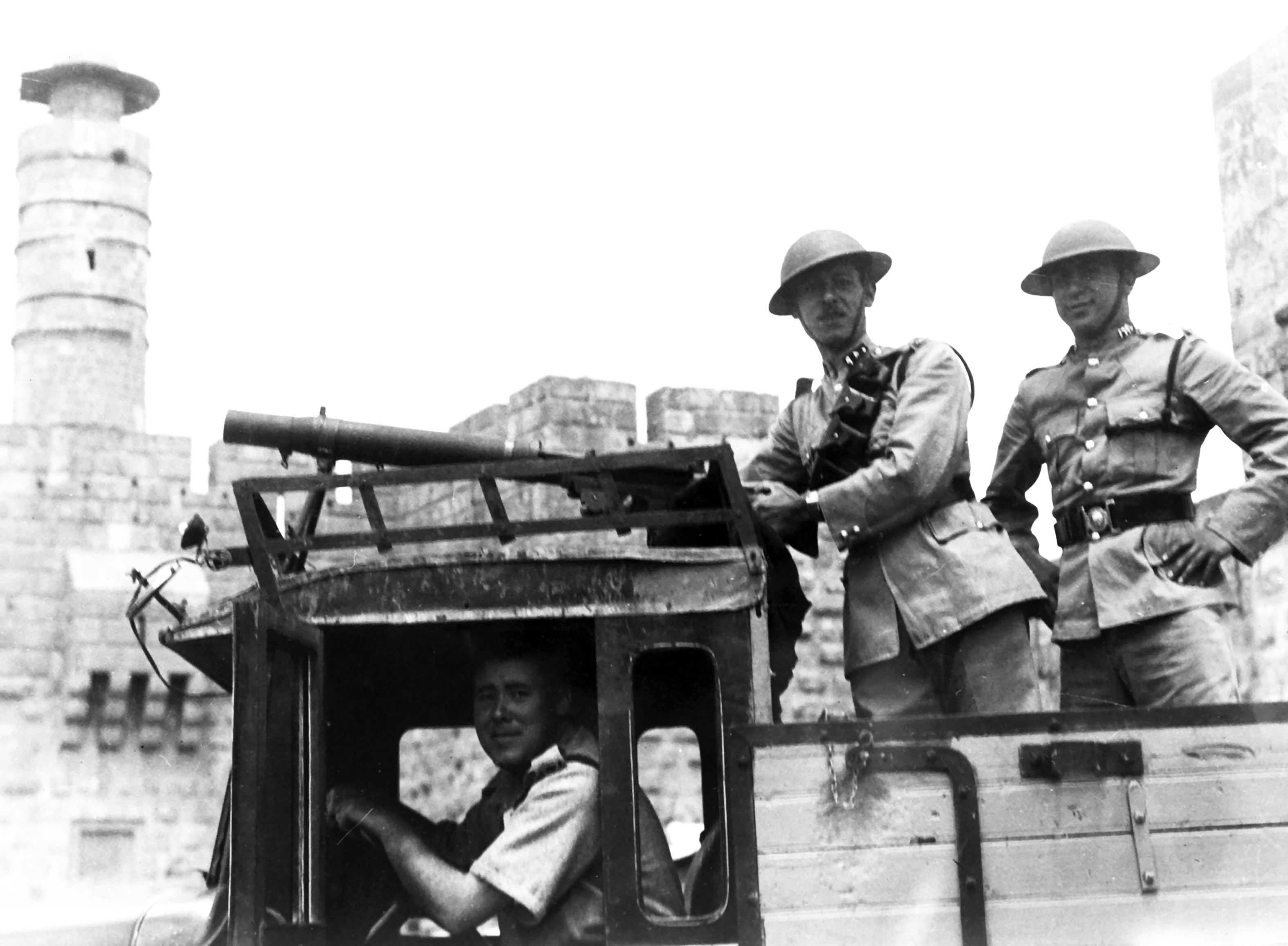
25: At one point, each kibbutz and moshav provided its own security to some degree.

54: Even the harbour areas of Haifa and, in this case, Tel Aviv, were not free from the threat of Arab attacks.
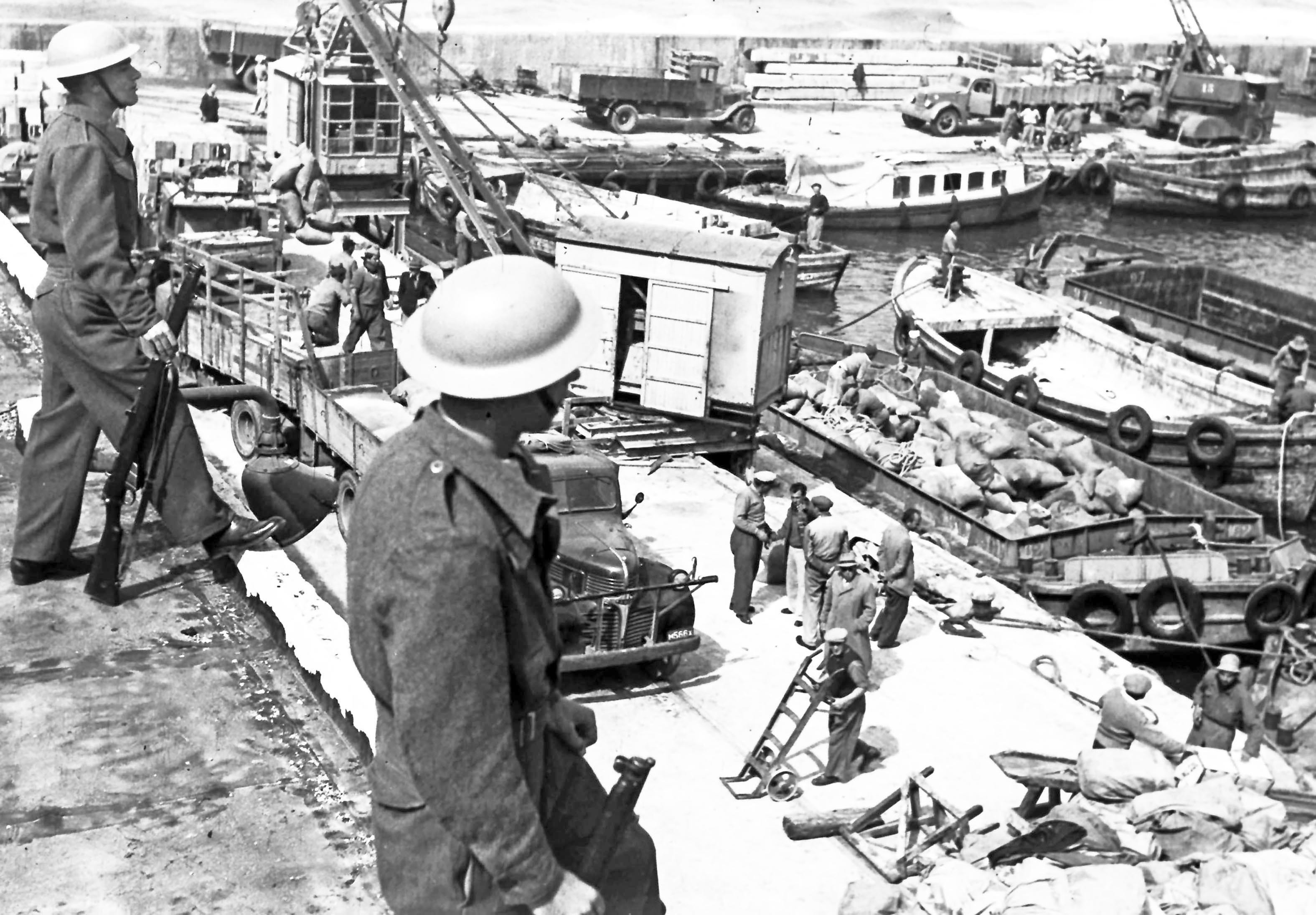
89:A significant portion of the fighting in the opening phase of the War of Independence was the ‘Battle of the Roads'.

122: Haganah established the Sherut Avir (Air Service) in November 1947.
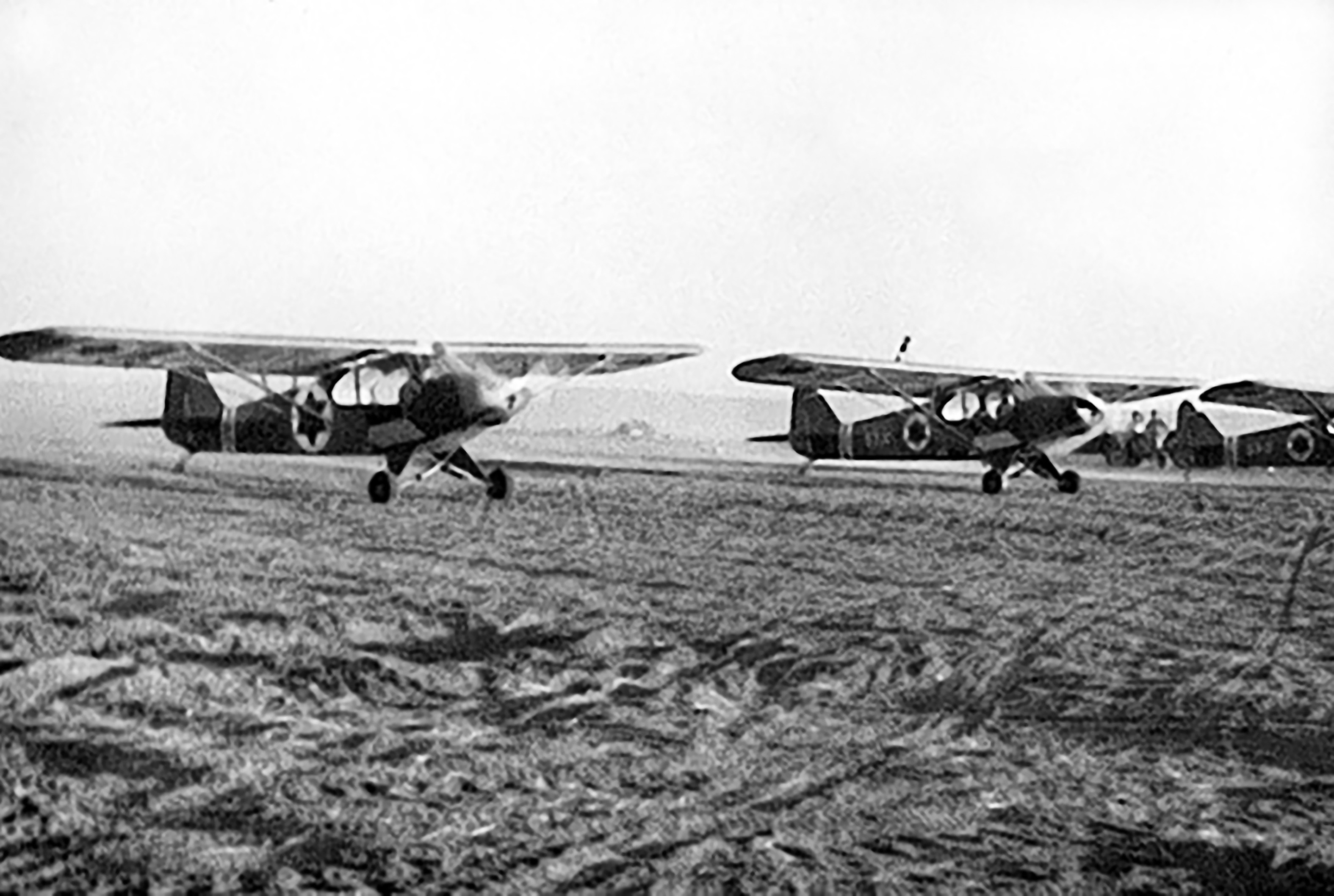
170: The 6th Battalion was nicknamed ‘The Jerusalem Battalion’

183 and 184: These two photographs show a knocked-out Renault R35 at Degania Alef,

184: caused by a Molotov Cocktail thrown by a small boy, while another was destroyed by a PIAT.
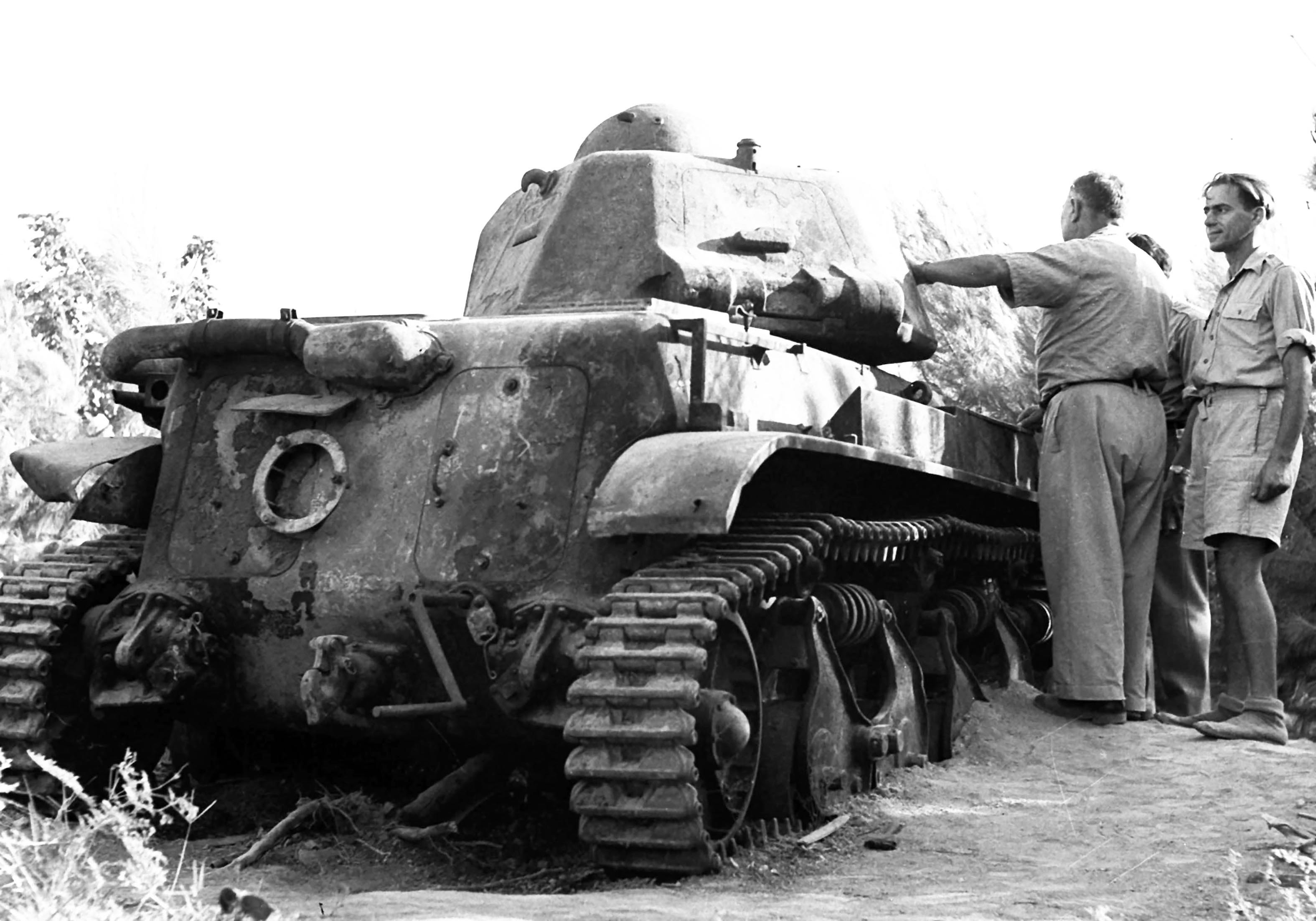
194: Knowing that the surrounding Arab nations had fully equipped air forces that would seriously impact Jewish forces

236: Vehicles and equipment captured from Arab forces, or possibly ‘acquired’ in various ways from the British,

261: This is a Ha’Negev half-track that was likely provided to them during the Truce

269: The origin of the Israeli Air force is a lengthy story for another time.
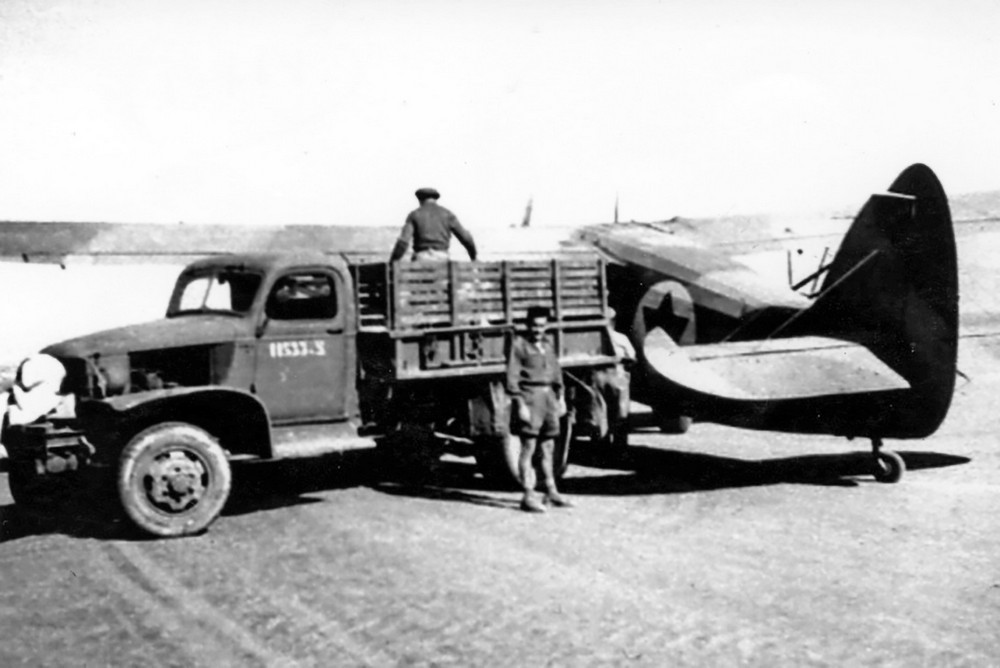
283 and 284: After two battalions from the 5th (Giv’ati) Brigade cut a wedge between Faluja

184: and Bayt Jibrin east of Iraq-Manshiya, the next step in Mivtza Yo’av was for the 82nd Battalion.

350: A lot of surplus World War II equipment, Boeing B-17 Fortress bombers
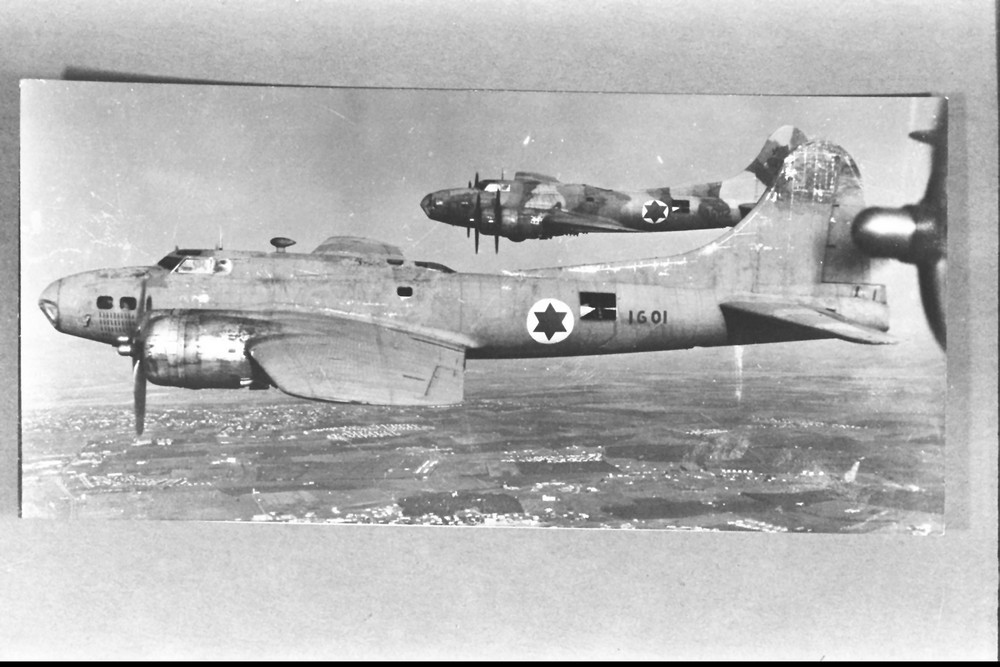
354: The airfield near Al-Majdal was also a target. This damaged Spitfire Mk.IX was left behind after it crashed landed.

367: The Egyptians also used air attacks, sometimes not so successfully. This Spitfire was shot down by the IAF
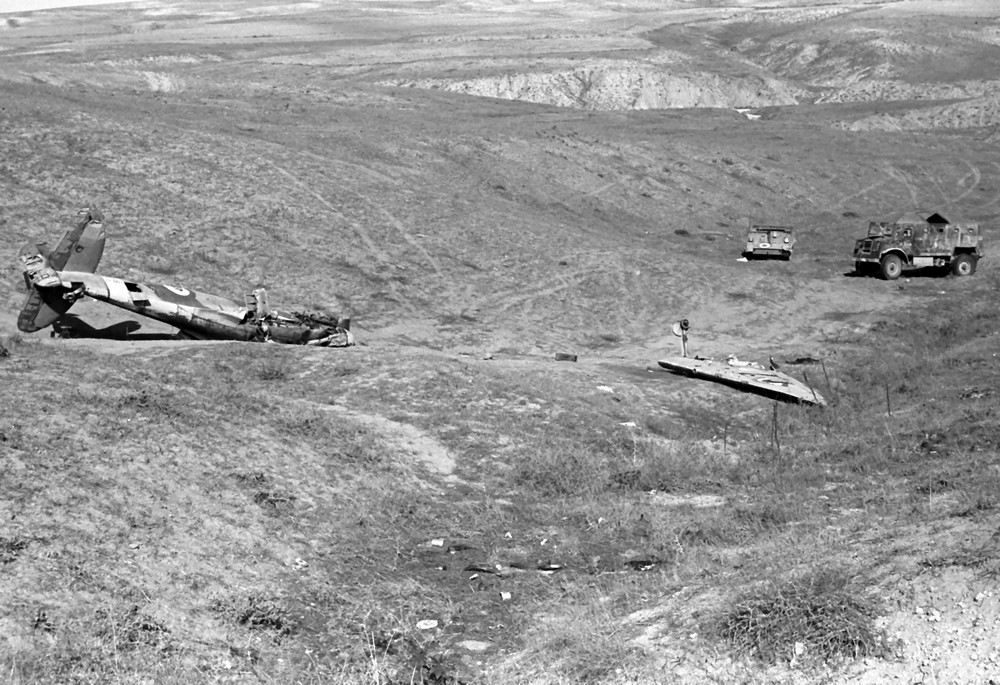
397: This IDF column crossing the Negev is rather interesting with such a variety of vehicles.

425: When the battle ended, the IDF had to deal with over 700 Egyptian POWs, some of whom are seen here.

446: The raising of the so-called ‘Ink Flag’ marked the unofficial end of the War of Independence.
